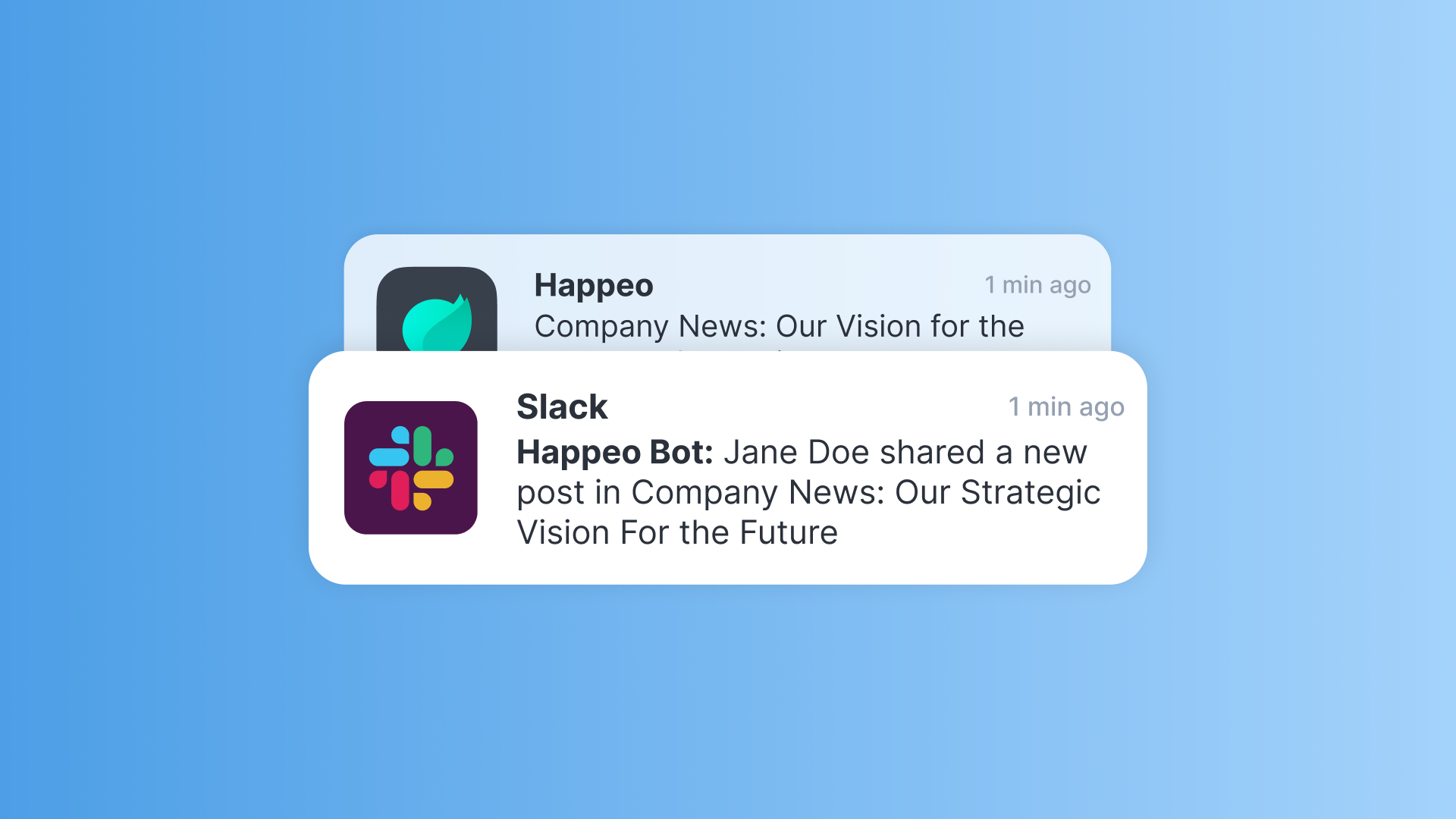
Internal Communications Comparisons
24 corporate intranet features that power employee productivity

15 mins read
Start building your digital home with Happeo
Request a demoInternal Communications Comparisons
Product
Features
Solutions
Happeo for
Use cases
Resources
Explore
Support
Happeo For
Use cases
Comparisons
Explore
Support
Recent

Jonathan Davies
15 mins read
Your company intranet should act as a digital workplace where hybrid and remote teams can come together and collaborate. It should be the place where they start their day, find the information they need to do their work, and engage and interact with their colleagues.
But these days, intranet software come with all sorts of different features and functionalities – and it can be tricky to figure out exactly what you need.
In this article, we’ll discuss 24 of the most important intranet features to look for in a company intranet, so you can make the right choice for your organization.
If you’ve spent time comparing the features of different intranet platforms, you’ll know it can quickly get overwhelming. There are so many different intranet features out there that it can be difficult to understand exactly what each one does — and whether you need it.
To help you make the right decision for your company, here are 24 of the most important intranet features to look out for when choosing a company intranet platform.
Your intranet is the perfect place to store everything from onboarding materials to quarterly targets to your company’s values statement. But there’s no point in having everything stored in one place if your employees can’t find it.
That means that a solution with a strong Intranet Search is essential. Some solutions (like Happeo) even allow users to search across multiple locations like email, shared drives, and the intranet at the same time.
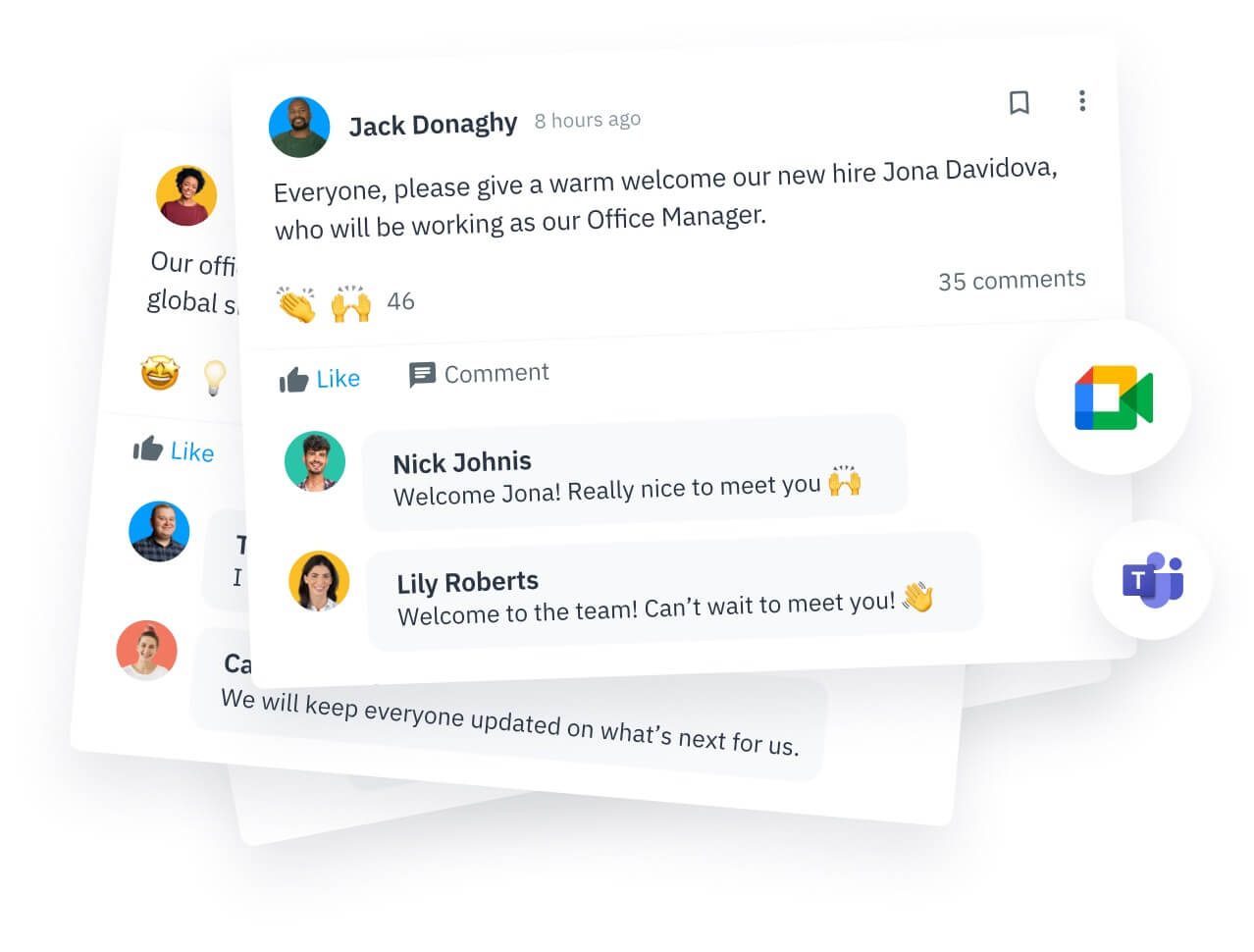
Whether it’s on Instagram, LinkedIn, or your employee intranet, a simple thumbs-up is the fastest, most familiar, and easiest way to demonstrate engagement on social posts.
But social intranet features shouldn’t stop there. Reacting to posts with emojis is a good start, but social intranet software should also include the option to comment and post in collaborative channels, tag other intranet users, and even share multimedia content like images, videos, or podcasts. Social features can also make new employees feel welcome.
As a business grows, so does the sheer volume of documents, files, and data you have to store. And without a solid system for keeping all of that organized, you’re headed for information chaos. Employees will struggle to find the information they need, or — worse — will end up working from information that’s out of date or no longer relevant.
A company intranet that acts as a robust knowledge management platform can help you to break down information silos, and provide democratized access to knowledge to everyone in your organization.
Your intranet should help you to create an organized structure for storing files and information, while also ensuring that files are kept secure. The best solutions also come with additional intranet features like lifecycle management, which helps you to eliminate old content or update it before it goes stale.
Governance controls support scalability. For example, if a 10-person team quadruples in size over a year, managers can adjust permissions for intranet channels and pages to prevent information overload. Businesses can also define how and in what way to share files so that growing teams know where to find what they need.
In most organizations, employees don’t have time to learn the ins and outs of a whole new complex program — which means looking for a solution with a simple, intuitive interface (on both desktop and mobile) is crucial.
Also, when you choose a simple and employee-friendly platform, you can get your employees up to speed and use the intranet to its full potential much faster. Happeo, for example, has a typical ramp-up time of just 6-8 weeks — pretty impressive compared to the industry average of 1.2 years. Speedy deployment is essential for a high adoption rate.
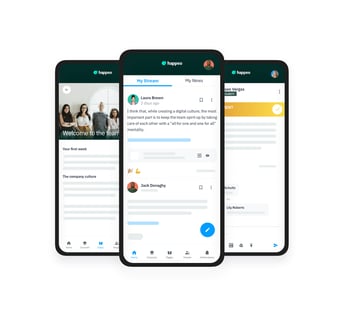
A company intranet can only reach its full potential if all of your employees can access it — which means you need a solution with a dedicated mobile intranet app. This is especially true for companies whose workforces include a mixture of office-based and frontline employees. But even if your whole team works from the office, there are still times when they’re stuck on their morning commute, waiting at the airport, or just having problems with their laptops — all cases where an intranet app can save the day.
Download list
Your intranet should allow team members to collaborate effectively by communicating with each other in real time. Look for an intranet platform that comes with in-built chat functions — or, better yet, integrates seamlessly with the communication tools your team already uses.
The best solutions include multiple options, such as one-on-one chat, group chat, and file sharing, so they can really act as a digital workplace where employees come together. An extensive search function is also key — no one wants to spend time scrolling through threads for that one message they think they received sometime last week.
An intranet content management system (CMS) is an essential tool that allows employees to create, edit and publish professional-looking content like blog posts, articles, and other documents, and distribute them to their colleagues. A strong intranet platform will allow you to easily embed media like images, graphs, and videos to engage employees.
When your intranet includes a CMS, everyone is invited to contribute to the conversation. This can boost employee engagement and help employees to feel more connected to your organization.
Once you’ve chosen and implemented your intranet platform, you need to know whether your employees are using it. More than this, you need to know how they’re using it, so that you can continue to iterate and create the best solution possible for your organization.
This means that you need a solution with Advanced Analytics functions built right into the platform. This key feature should tell you not only which employees are using your intranet, but when, where, and how they’re using it, too.
With some platforms, you can also get valuable search analytics, which allow you to track what your employees are searching for and whether or not they found the information they need.
Even a simple people directory can give you an overview of who everyone in your organization is, what they do, and where they’re located. More advanced solutions even allow you to search by skills as well as job titles and locations.
Employee profiles include details about who people are beyond their job titles. So whether you’re looking for someone in HR who speaks French, or trying to find some fellow “Swifties,” you’ll be able to pull up the right employee profiles in seconds.
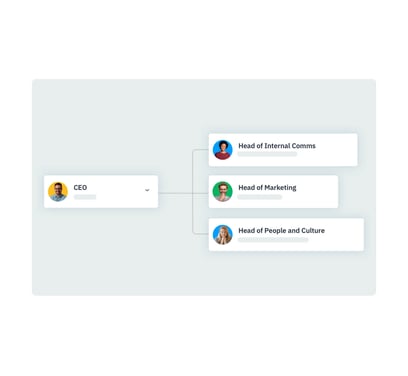
Even in smaller organizations, knowing who’s who isn’t always easy, especially for hybrid or remote workers. Thankfully, modern intranet solutions like Happeo automatically create a simple organizational chart that clearly shows how everyone fits together.
Want to make your employees’ lives easier? Choose an intranet that offers seamless integration with tools like Google Workspace or Microsoft 365. That way, instead of having to abandon the workflows they’re used to, they’ll be able to find information, collaborate on shared files, and even set up meetings or video calls — with the added convenience of accessing everything from one central location.
Depending on your needs, you can connect your intranet with project management tools, IM software, sales platforms, and more. Many intranet platforms will even allow you to build your own integrations through an open API — so there’s really no limit to what your intranet can do.
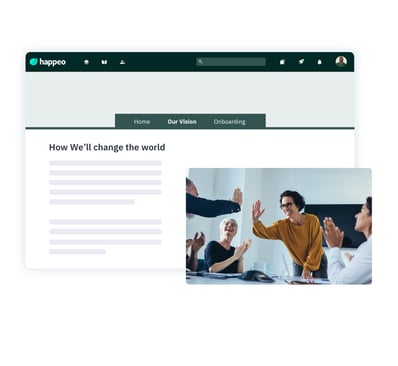
An intranet page is essentially an internal web page that you can create for any team, department, or project. A well-organized intranet might have pages for HR, sales, product development, and more. Put together, the whole thing works like a mini-encyclopedia that tells your employees everything they need to know about your company.
Another important intranet function that some solutions provide is a customizable homepage. Think about it: Not everyone will use your intranet in the same way or need regular access to the same information, so it makes sense for each employee to be able to switch up their homepage to make it work for them.
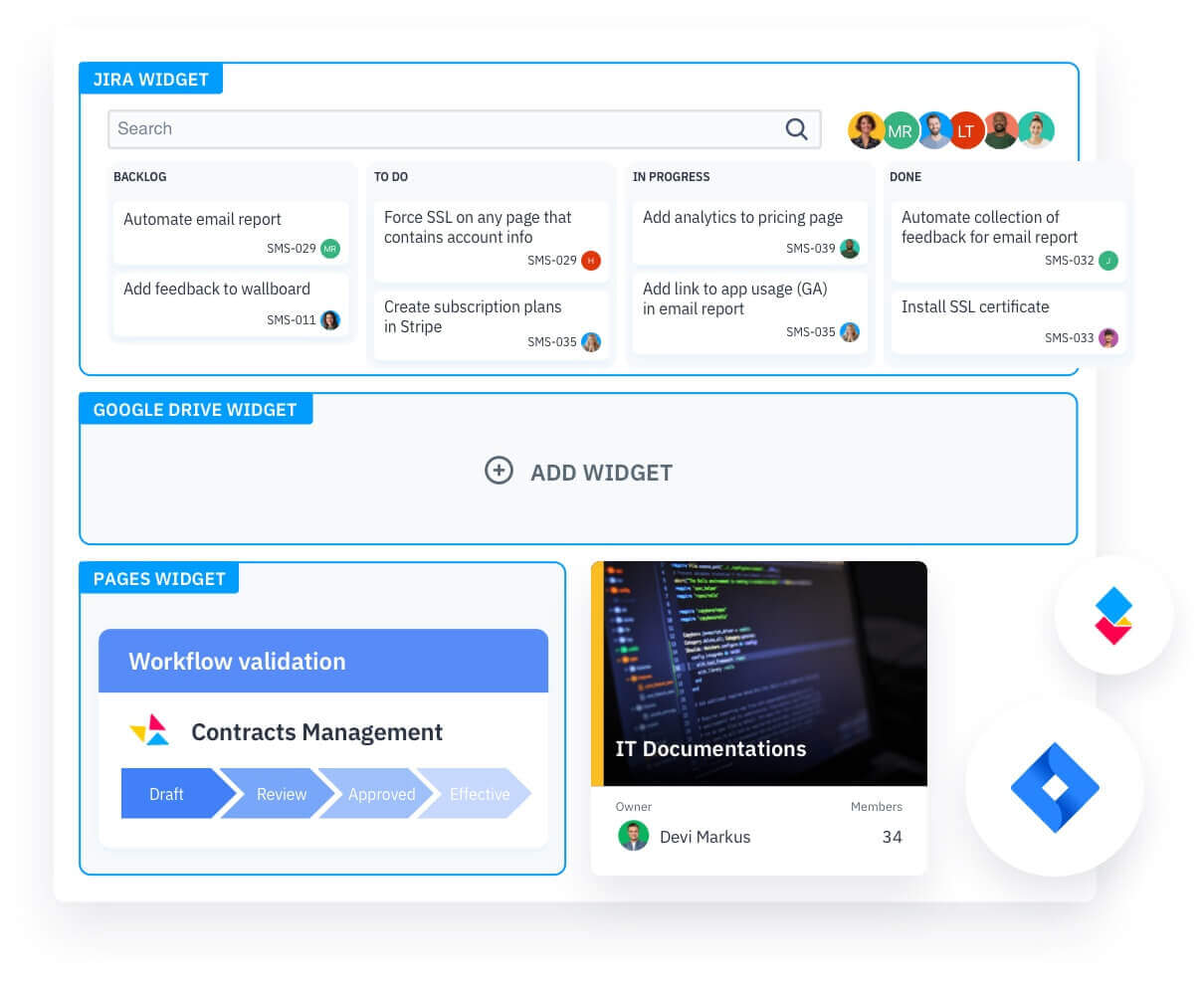
To create beautiful, tailored intranet pages, you need customizable widgets, because they allow you to embed almost anything into your page. Want employees to get easy, instant access to a Google Drive file from your HR page? Use a widget. Need to add a calendar to a page dedicated to a specific project so employees can see important dates and deadlines at a glance? There’s a widget for that. Want to make sure everyone can see the latest weather report or local traffic updates, right from their home page? You get the idea.
While the best intranet platforms should make creating pages easy, it’s even easier when they allow you to save pages as templates and reuse them again and again. By creating a library of templates that your employees can use whenever they need to create an intranet page, you can save them valuable time (and increase intranet usage too).
Book demo
Your intranet contains a lot of data on your company, your employees, and potentially your customers. That means that you need to be sure the solution you choose will keep your information safe. Different internet platforms come with different levels of security, so it’s important to do your research.
With Happeo, for example, all of your data is securely stored in Google Cloud, which means you benefit from Google’s industry-leading security standards. Happeo has also achieved ISO 27001 certification, an international standard that shows a company has invested in the people, processes, and technology needed to protect an organization’s data.
Every good intranet platform should allow you to create workspaces for different teams, project groups, or departments. These make it easier for specific employees to work together while keeping your intranet organized and uncluttered for everyone else.
Plus, a virtual workspace doesn’t just have to be about work. Many organizations create fun spaces for employees to come together and discuss shared interests from sports to music to pets!
Surveys and polls are both valuable tools that allow your employees to share their ideas and opinions. You can use pulse surveys to measure things like employee engagement and satisfaction, helping you to understand the feeling on the ground in your organization.
And polls can be used to great effect to gather your employees’ feedback on anything from new office policies to intranet content to the new company logo. By using an intranet solution that includes the functionality for both polls and surveys, you can make it easier than ever for employees to respond and share their valuable insights.
In almost every organization, there are times when you need to get a message out to everyone — fast. To make this as easy as possible, look for solutions that include a push notification feature. This means you can send an instant notification to both desktop and mobile devices across your entire team, department, or organization — and know they’ve got the message.
Intranet calendar integration helps employees review their day and week at a glance, without opening a different application. Employees should also be able to see others’ calendars for quick-and-easy meeting-planning purposes.
In 2022, not everyone works from the office — at least not full-time. If you want your intranet to be available to everyone, you need to make sure it’s a cloud-based solution that they can access securely from anywhere. That way, employees will be able to find answers to questions, chat with colleagues, and securely access shared files whether they’re in the office, working remotely from home, or getting a bit of work done on the commute.
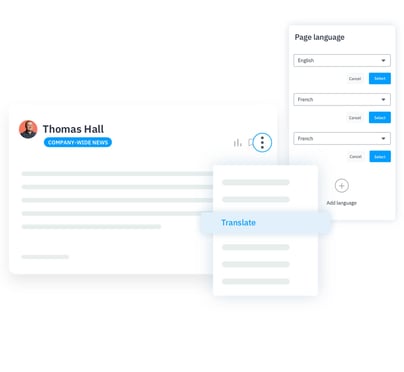
If your company is multinational, there’s a good chance that your employees don’t all have the same mother tongue. And an intranet isn’t truly accessible if not everyone can see it in their language.
Some intranet providers allow you to create a multilingual platform, either by using in-built automatic translation software or by leveraging human translators for more accurate content. Either way, ensuring your intranet works in multiple languages can help you to create alignment and bring your employees together — even in the largest organizations.
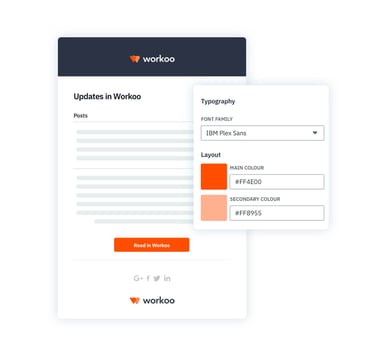
An intranet should strengthen and build on your company culture, which means it needs to represent your brand. Some solutions allow you to create a fully branded environment that incorporates your company logo, typefaces, and colors so that your team feels at home right away. Others even let you set up a custom URL and/or a custom login page. When your platform looks familiar to your employees before they’ve even used it, the barrier to entry is lowered — which means you’ll likely see higher intranet adoption and engagement.
Not all intranet platforms come with all of the features listed above. It’s up to you to set priorities and choose the right intranet for your organization.
For example, some organizations prefer tools that allow for fast-paced collaboration and look for features like team workspaces, easy access to shared files, and strong integrations with collaboration suites. Large, multi-national organizations might prioritize intranet features like organizational charts, company news feeds, and multilingual platforms.
If you’re looking for a modern intranet platform with all the key features you need to solve information chaos, bring your employees together and help them to feel happier at work, you might want to give Happeo a try.
Happeo acts as a single source of truth for your organization, bringing all of your internal communications, knowledge, and content together in one convenient hub. Employees can collaborate, chat, and socialize in Channels, and customize their own homepage to get the best intranet experience. Our full Branding Add-On means you can make Happeo your own and ensure everyone feels at home as soon as they log on.
Plus, Happeo comes with rich integrations with Google Workspace, Microsoft 365, and more — meaning it’s the perfect tool to slot neatly into your existing stack.
Want to give Happeo a try? Request a free demo to find out more.
